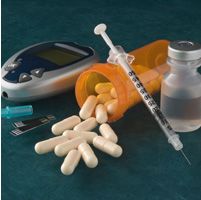Article
Eliminating Hepatitis C with Antiviral Drugs Improves Diabetes Control, Study Finds
Author(s):
Eradicating the hepatitis C virus (HCV) with direct-acting antiviral (DAA) drugs improves the control of glucose levels in patients with type 2 diabetes (T2D), a new study suggests.
Eradicating the hepatitis C virus (HCV) with direct-acting antiviral (DAA) drugs improves the control of glucose levels in patients with type 2 diabetes (T2D), a new study suggests.

The findings provide “additional justification” to consider DAA therapy for individuals with HCV and diabetes, according to authors led by Justine Hum at the Portland Veterans Affairs Medical Center in Oregon.
“The treatment of HCV has the potential to impact a remarkable proportion of the population not only with respect to liver disease but also diabetes control,” the authors wrote.
Both HCV and T2D are prevalent in the US. About 29.1 million people, or 9.8% of the population, have diabetes, while 3.5 million (1.4%) are infected with HCV.
T2D is nearly 4 times more likely to develop in patients with HCV than in those without the liver-attacking virus, the authors said.
Previous research has shown that insulin resistance — and the elevated glucose levels it can cause — declines when HCV patients are treated with interferon-based therapy. However, no similar review has been conducted involving antiviral drugs administered to people with diabetes and HCV, according to the study.
Hum and colleagues at Veterans Affairs centers in Portland and Seattle, Washington, set out to investigate. They looked at 2,435 diabetic patients who had been treated with DAAs in national veterans centers from January 2014 to October 2015. Of this group, 2,180 had achieved sustained virologic response (SVR) and were considered cured of HCV.
The team considered 2 criteria, comparing changes in patients’ average hemoglobin A1c (HbA1c), or the level of glucose concentrations in plasma, between individuals who had achieved SVR after taking DAAs and those whose treatment failed. They also assessed the use of anti-diabetic medications in the two groups. The researchers documented both measures one year before and one year after antiviral treatment.
The patients with elevated HbA1c at the start of the study who achieved SVR saw a greater drop in their HbA1c after antiviral treatment than those who failed to reach SVR. The comparison was 0.98% to 0.65%, according to the study.
The use of anti-diabetic drugs also decreased more in patients who reached SVR than in those who did not. The difference was especially significant for the use of insulin, which dropped from 41.3% to 38% in those where DAAs eliminated the virus — compared with an increase from 49.8% to 51% in those whose treatment failed.
“Patients not only have an improvement in HbA1c level after achieving SVR, they are also less likely to require insulin,” the researchers concluded.
The authors noted that one limitation to their study was the inability to determine whether patients had received additional medications outside the VA system.
The study, “Improvement in Glycemic Control of Type 2 Diabetes After Successful Treatment of Hepatitis C Virus,” was published online June 28 in Diabetes Care.
Related Coverage:
Why Doctors Should Stop Writing Opioid Prescriptions by Hand
Empagliflozin Shows Benefits on Albuminuria
Generic Direct-acting Antivirals for HPV Prove Effective, Cost-saving in India Study
2 Commerce Drive
Cranbury, NJ 08512
All rights reserved.




